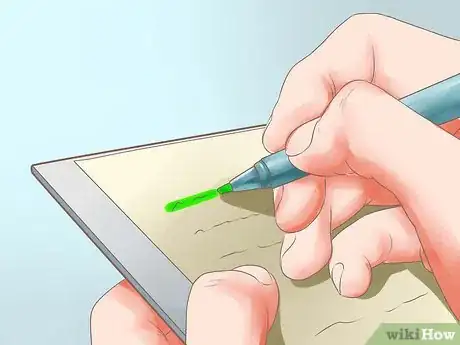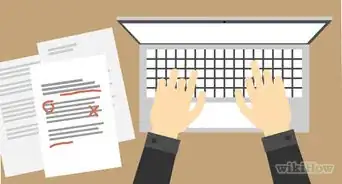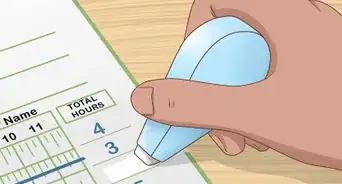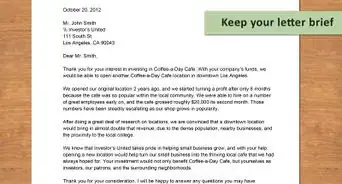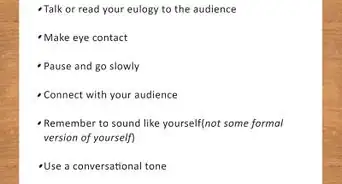wikiHow is a “wiki,” similar to Wikipedia, which means that many of our articles are co-written by multiple authors. To create this article, 11 people, some anonymous, worked to edit and improve it over time.
This article has been viewed 24,489 times.
Learn more...
The best way to receive sponsorship is to put together a great proposal. It's perhaps the most important step in the process of seeking sponsorship and actually attaining it. Depending on how well or poorly a proposal is written, it can make or break the deal. So think about creating the most informative document you can.
Steps
Getting Started
-
1Come up with a clear, overarching objective for your proposal. Make sure that you know exactly what you'd like your project to accomplish. Remember that if you only have a vague or broad idea, it'll show in your writing. To start:
- Compose a well-defined idea, such as Creating A More Effective Curriculum For K-12 Instructors, or Creating A Better Way To Assist Lab Technicians.
- Talk to people who are knowledgeable on your topic. Their statements and answers can deepen and help your own thinking.
- Run your central point by someone who is unfamiliar with the subject. Doing so can give you a sense for how clearly you formulated your intent.
-
2Try to incorporate your project into your everyday life. Keeping it at the forefront of your mind might help you refine it.
- When you encounter a problem, try asking yourself if your idea would be a helpful solution. The point of this exercise is to expand the scope of your project, but also to realize its potential limitations.
Advertisement -
3Conduct preliminary research. Get a feel for what's already out there on the topic. A web search can be quite useful at an early stage - but be discerning of what you read, and keep an open mind.
- Run a web search with your central claim in the subject line.
- Stay away from blogs, forums, and sites that are primarily advertisement driven.
- Mark new or useful information, and remember where you found it so you can easily go back to it.
-
4Deepen your research. The library is always a good choice, but Google search can be your friend here, too - as long as you discern between reputable and non-reputable sources. This step is very important as it lays the foundation for an effective or ineffective proposal.
- Look for government-sponsored sources. In web searches, these website addresses end with .gov.
- Scholarly sources are always a good choice. In web searches, these website addresses usually end in .edu.
-
5Identify supporting arguments for your project. See what other like-minded people think, and zone in on their most useful points for your cause. Think about questions such as:
- How did they tackle the issue?
- Did they effectively solve the problem you're presenting?
- What were some of the difficulties they encountered when dealing with this issue?
- How is their approach similar or different from yours?
- How do you agree or disagree with their research and conclusions?
-
6Identify opposing arguments for your project. Sometimes, understanding your opposition can be even more helpful than knowing your supporters because it can strengthen or highlight your argument's weak spots. Think about such questions as [1] :
- What approach did they take?
- Why did it work for them, and how is it different from yours?
- What do they criticize about approaches like yours, or similar ones?
- How do you agree or disagree with their research and conclusions?
Writing Your Proposal
-
1Create a Title Page. This is the first thing your audience sees, and you want it to contain the basic information about you, the author. Make sure to include the following pieces[2] :
- The name of the organization seeking funding.
- Contact information for the official representative, most likely you (address, telephone number, fax number, and e-mail).
- Name of institution or organization to which you're submitting the proposal.
- Title of project.
- Total amount of funding requested.
- Timeline for project.
- Signature of official representative, most likely you.
-
2Write a table of contents. Your reader should know exactly where to find information on the various parts of your project. Include:
- List the sections, and subsections, of your proposal with page numbers.
-
3Insert your abstract. This should be a concise and explicit explanation of what you're trying to accomplish. Remember to keep the abstract at a one page maximum.Things to consider when writing your abstract might be:
- Emphasize your objectives.
- Why is your idea necessary? Why would it be a marked improvement to existing practices?
- Who will benefit directly from your project?
- How will you conduct the project? What methods will you use?
- What is the timeline for the implementation of your idea(s)?
- How much will it cost?
- Outcomes, and possible future applications.
-
4Explain your methodology. In other words, in which manner will you approach the issue? This section can and should include a clear review of the research you've conducted. Some things to consider:
- Mention who else has worked on the problem before you.
- Explain what the pros and cons are of your approach.
- Explain the positions taken by supporters and opponents of your, or similar methods.
-
5State your plan of operation. This is the part where you provide lots of detail about the steps to be taken according to your methodology. Consider the following:
- Clearly identify how and where your project will have an impact.
- Document the significance of your project for its target population, or for the research questions it seeks to address.
-
6Explain the budget. If cost is involved, you need to provide a lot of detail. Put together a detailed budget for categories that involve funding. You want to give your potential sponsor as much information as possible about where her/his money will be going. Think about categories such as:
- Materials and supplies
- Personnel
- Equipment
- Travel
- Direct and indirect costs
-
7Explain how you plan to disseminate the project, or information, gathered by the project. This could occur in a variety of ways, as for example[3] :
- Through publications in scholarly or professional journals.
- Through presentations or talks.
Submitting Your Proposal
-
1Know to whom your proposal should be addressed. This is very important as you don't want your hard work to go to the wrong person and potentially get lost.
-
2Check the submission deadline. The last thing you want is for your project to be disqualified just because it's late. Check and check again.
- Ask your potential sponsor for the submission timeline to also get a better idea for when you'll be notified of your proposal's status.
-
3Check your sponsor's mailing instructions. Some places might not be open to an electronic submission, and might prefer you to physically mail it.
References
About This Article
To write a proposal for a sponsorship, start with a cover page that includes the name of your organization, contact information, and the amount of funding you’re requesting. Additionally, include a table of contents so the reader can find information more easily. Next, write a short and clear explanation of what you’re trying to accomplish and why you need funding. In the following pages, explain how to you plan to achieve you goal, your budget, and how you’ll spread the word about your project. For tips on how to get your proposal to the right person, read on!








